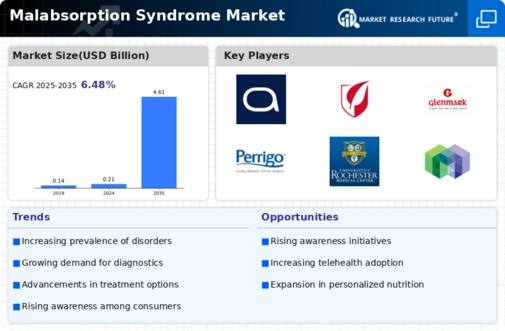Malabsorption Syndrome Size
Malabsorption Syndrome Market Growth Projections and Opportunities
The Malabsorption Syndrome market, a field within the healthcare industry, experiences a range of market share positioning strategies as companies navigate the complexities of addressing this condition. One prominent approach is product differentiation, wherein companies strive to offer unique and innovative solutions to distinguish their products from competitors. This could involve the development of advanced therapies, specialized nutritional supplements, or diagnostic tools with enhanced accuracy. By providing distinctive products, companies aim to capture the attention of healthcare professionals and patients, positioning themselves as leaders in delivering effective and cutting-edge solutions for malabsorption syndrome.
Cost leadership is another significant strategy employed in the Malabsorption Syndrome market. Companies work towards providing cost-effective treatments without compromising on quality. This approach is particularly relevant in healthcare, where patients and healthcare providers are sensitive to the economic implications of treatment. Achieving economies of scale, optimizing production processes, and negotiating favorable terms with suppliers are common tactics to keep costs in check, making the company's products more accessible and appealing to a broader market.
Effective market segmentation is crucial in the Malabsorption Syndrome market, given the diverse underlying causes and patient populations. Companies often tailor their products to address specific types of malabsorption or target patient demographics. For instance, creating specialized nutritional supplements for individuals with gluten sensitivity or developing therapies for specific malabsorption-related diseases allows companies to address niche markets with precision. This targeted approach helps in building a strong market presence within specific segments and ensures that products meet the specific needs of particular patient groups.
Strategic partnerships and collaborations play a pivotal role in the Malabsorption Syndrome market. Companies frequently engage in alliances with research institutions, healthcare providers, and other industry stakeholders to enhance their understanding of the condition, improve research capabilities, and accelerate the development of new treatments. By leveraging shared expertise and resources, companies can position themselves as leaders in the field, fostering innovation and strengthening their market share.
Customer-centric strategies are also paramount in the Malabsorption Syndrome market. Given the chronic nature of this condition, patients often seek ongoing support and education. Companies that prioritize patient education, provide comprehensive support programs, and ensure ease of access to their products contribute to increased patient satisfaction and loyalty. Satisfied patients are more likely to adhere to prescribed treatments, positively impacting the market share of the companies providing these solutions.
Geographic expansion is another essential aspect of market share positioning in the Malabsorption Syndrome market. Companies often target regions with a higher prevalence of malabsorption-related conditions or where there is an unmet need for effective treatments. Establishing a strong presence in key markets enables companies to address regional variations in healthcare practices and preferences, ultimately contributing to a broader market share.












Leave a Comment